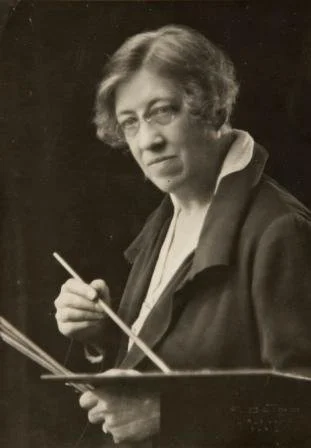“You must forgive my enthusiasm; it means just everything to me. Nothing else is of the smallest or faintest importance beside that.”
– Agnes Goodsir
Agnes Noyes Goodsir is neither well-known by studiers of queer history nor unfairly shunned. Instead, she falls into the familiar category of quiet lack of acknowledgment. Living from 1864 to 1939 and moving to France during the 1920s, it was not impossible for lesbians to be open about their sexuality, nor was it uncommon for them to choose to keep such information private. She made the completely normal choice of keeping her sexuality more or less under wraps. That is not, of course, to say that it was a well-hidden secret. With a beloved ‘companion’ she lived with and publicly said to be her muse, her frequenting of lesbian spaces, and connections to the lesbian community in France, she was not working particularly hard to hide this fact. Neither was she advertising it.
Now widely regarded as a feminist painter, many of Agnes Goodsir’s paintings challenged the common patriarchal values of the art scene. There would be no difficulty finding long and in-depth analyses of her life’s works if one was looking. On the other hand, her personal life is mostly relegated to a few simple facts. She was in love with a woman named Rachel Dunne. She moved from Australia to Paris. She moved in lesbian circles. More or less, anything else about her is eclipsed by the love for her art, which is widespread and well-earned. She is not known to have a trail of scandalous love affairs following her name. Though it is widely accepted that she was a feminist, that understanding mostly comes from her life circumstances and works. Most notably for this project, her words describing her own life and experiences are scarce and difficult to find. What is known about her is largely from others’ accounts, except her paintings.
Through other accounts, the story of her life is bare bones. In Australia, she was born to David James Cook Goodsir, and Arthur Woodward taught her art. On the encouragement of Woodward, she would move from Australia to study art internationally, as he often encouraged his students to do. She would visit London and meet Rachel Dunne and Dunne’s husband. After divorcing said husband, Rachel would travel to Paris with Agnes. The two would live together as muse and artist. The two were often photographed together and with other women who were openly lesbian or later known to be queer in some way. Her paintings were reasonably well known.
Through looking at her work and the time in which she lived, a story becomes clear. Throughout her time in Paris, her paintings were mostly of women. She would paint them as central focuses, with clothing and expressions that challenged the popular understandings of women at the time. Daringly, she painted bare skin on women in a time when that was a right reserved and controlled by men. There were many symbols and small details throughout her paintings representing androgyne, different understandings of gender, and the idea of gender equality. Her muse was Rachel Dunne, whom she would sometimes call “Cherry.” Rachel and Agnes would live together after Rachel’s divorce from her husband, though Agnes was recorded in legal documents as a “spinster.” Agnes would live and explore places in Paris that were known for their popularity among men. In photographs, it has been noted that the clothes Agnes would wear were more masculine leaning for the time. In writing about her work as an Australian expatriate, Stephen Rainbird would write:
“It may be argued that Goodsir’s greatest achievement lay in representing one of the most important sociological developments of the period, the new androgynous image, which the paintings of a modish Cherry personify.”
The study of Agnes Goodsir is a study in interpretation. Unlike other people this project has looked at, her own view of her life is not written in a diary for the world to see. She is remembered instead in the visual medium, through photographs and paintings. Rainbird would also write:
“Like many women artists of her generation, Goodsir was the exemplary quiet achiever.”
Understanding her comes not only through looking at bare facts but through looking beyond and behind the easel. Her legacy is not bombastic or expansive, but she can be found in the implications behind simple facts.
Rachel wrote after Agnes’ death:
“I am alone after 30 years.”
That, from all of her work, women around the world have found a deep and abiding connection. Most telling of any of these facts is that after Rachel died, she was buried next to Agnes.
REFERENCES AND FURTHER READING
Disclaimer: some of the sources may contain triggering material
Agnes enigma. (n.d.). Portrait Magazine. Retrieved March 20, 2022, from http://www.portrait.gov.au/magazines/62/agnes-enigma/
Agnes Goodsir. (n.d.). Obelisk Art History. Retrieved March 20, 2022, from https://arthistoryproject.com/artists/agnes-goodsir/
Agnes Goodsir, b. 1864. (n.d.). National Portrait Gallery People. Retrieved March 20, 2022, from http://www.portrait.gov.au/people/agnes-goodsir-1864/
Agnes Goodsir: Biography at: At Design and Art Australia Online. (n.d.). Retrieved March 20, 2022, from https://www.daao.org.au/bio/agnes-goodsir/biography/
Agnes Goodsir Still life: Study of lemons c. 1930 | Geelong Gallery. (n.d.). Retrieved March 20, 2022, from https://www.geelonggallery.org.au/collection/explore-the-collection/agnes-goodsir
Agnes Noyes Goodsir (1864 – 1939) A Lesbian Painter | Feminine Moments. (2014, August 26). https://www.femininemoments.dk/blog/agnes-noyes-goodsir-1864-1939-a-lesbian-painter/
Girl with Cigarette—Selection from Bendigo Art Gallery. (n.d.). Culture Victoria. Retrieved March 20, 2022, from http://www.cv.vic.gov.au/stories/creative-life/selection-from-bendigo-art-gallery/girl-with-cigarette/
Gorman, T. (n.d.). BRAVE, TALENTED AND OVER THERE. 6.
Gorman—BRAVE, TALENTED AND OVER THERE.pdf. (n.d.). Retrieved March 20, 2022, from http://www.ozarts.net.au/images/oz-arts/2018-winter/clem-and-therese-gorman.pdf
LGBT Daily Spotlight. (n.d.). Retrieved March 20, 2022, from https://lgbtdailyspotlight.com/june-18th-2016-people/
maryannadair. (2015, August 20). How Rachel’s Goodsir became My Fair Lady. MaryAnn Adair’s “Is It Art” Blog. https://maryannadair.com/2015/08/20/how-rachels-goodsir-became-my-fair-lady/
Matt & Andrej Koymasky—Famous GLTB - Agnes Noyes Goodsir. (n.d.). Retrieved March 20, 2022, from http://andrejkoymasky.com/liv/fam/biog2/goodsi01.html
Queering the collection | Art Gallery of NSW. (n.d.). Retrieved March 20, 2022, from https://www.artgallery.nsw.gov.au/art/watch-listen-read/read/queering-collection/


